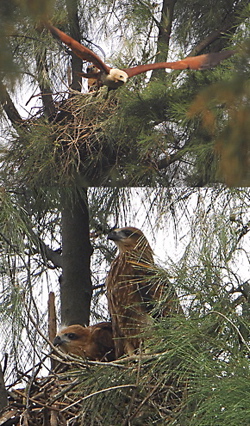In March 2007, Mark Chua came across a nesting pair of Brahminy Kites (Haliastur indus) (above) raising two large chicks in a nest lodged high up in the fork of a tall casuarina tree (Casuarina equisetifolia). He managed to document the chicks in the nest, their fledging as well as many dramatic flight shots.
Like most other raptors, the nest is a large, untidy pile of sticks (left). According to Naoroji (2006), the nest is usually lined with common discarded items like rags, strings, pieces of plastic, etc. However, this cannot be confirmed here as the images failed to show other than twigs. It is also reported that the birds build a new nest each season, sometimes recycling the old nest materials, at times even reusing the old nest after some repairs.
Wells (1999) states that the inner cup of the 60-90 cm diameter and 15-30 cm deep nest is lined with a pan of dried mud, 10-15 cm across.
Two or even three eggs are normally laid and both sexes share in the incubation duties. In this instance two chicks were raised (left bottom).
As reported by Wells (1999), food is often eaten directly while soaring.
This large kite has a striking plumage of rufous-brown and white as an adult. The head, neck to mantle, and throat to upper belly and flanks are all white. In the nominate subspecies, indus, that is seen in the Indomalayan region, the white has finely darkish streaks (top).
From below in flight, the white head, neck and breast contrast sharply with the chestnut lower belly, deep chestnut underwing-coverts with pale chestnut-buff under flight feathers with contrasting blackish primary fingers.
The juvenile is mostly brown, and this has been reported to vary with the season. From below the white-tipped underwing-coverts and large white wing panels are prominent.
Mark Chua
Singapore
August 2007
References:
Naoroji, Rishad (2006). Birds of prey of the Indian subcontinent. London: Christopher Helm.
Wells, D.R. (1999). The birds of the Thai-Malay Peninsular. Vol. I, Non-passerines. Academic Press, London.










